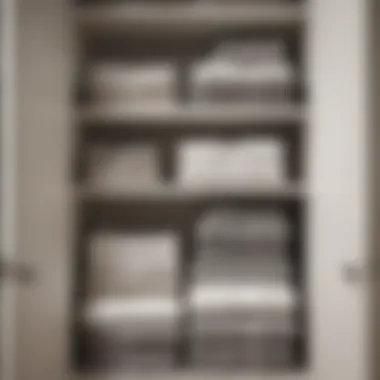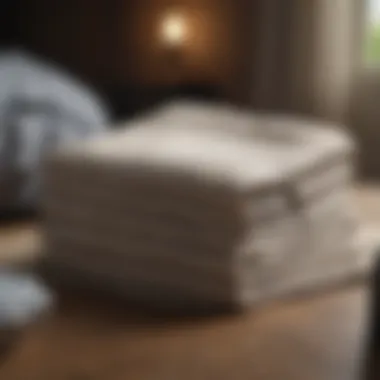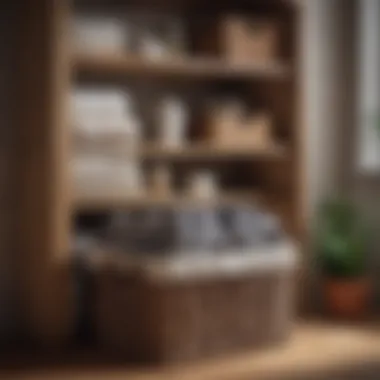Mastering Linen Organization: Your Complete Guide


Intro
Organizing linens in a home can be an often overlooked yet vital aspect of interior management. Whether they are bed sheets, towels, or tablecloths, how you store these items plays a crucial role in maintaining order and enhancing the function of your living space. With a systematic approach, home owners can effortlessly access their linens, ensuring they remain in pristine condition while optimizing available storage.
This guide provides a thorough exploration of effective linen organization methods. It offers unique insights into selecting appropriate storage solutions, implementing sorting systems, and maintaining item condition. From various fabric types to suitable folding techniques, each section will equip the reader with actionable information to streamline their linen inventories.
The importance of linen organization stretches beyond mere aesthetics. An organized linen system contributes to a more efficient household routine. In a world where time is a precious resource, knowing where your items are can save unnecessary hassle. This article aims to empower homeowners and design enthusiasts alike to create a functional and stylish linen storage environment.
Understanding Linen Types
Understanding different types of linens is essential for efficient organization in your home. Not all linens serve the same purpose or require similar care and storage methods. By distinguishing between categories of linens, you can tailor your organization system. This allows for easy access when needed and prevents clutter and confusion. Knowing the materials used in your linens can also guide maintenance and longevity.
Categories of Linens
Bedding linens
Bedding linens, such as sheets and duvet covers, are fundamental for a good night’s sleep. They directly impact comfort and aesthetic appeal of the bedroom. A key characteristic of bedding linens is their variety of fabrics and thread counts available. Higher thread counts can lead to softer and more durable options, making them a popular choice. However, they may come at a higher cost.
Unique feature: Bedding linens often require specific care to maintain their quality, such as washing in cold water and avoiding bleach. The advantages of proper care extend the life of these linens, but this also demands more attention from the homeowner.
Bath linens
Bath linens consist primarily of towels and washcloths. Their primary purpose is functionality and comfort after bathing or swimming. A critical aspect of bath linens is their absorbency, often highlighted by material choices. High-quality towels made from cotton or bamboo tend to offer superior absorption and quick drying.
Unique feature: Bath linens come in standard sizes which can be categorized easily, making them simple to store. However, their tendency to develop mildew if not dried properly is a downside.
Table linens
Table linens include tablecloths, napkins, and placemats. They add an element of style to dining settings. The characteristic of table linens is their ability to protect dining surfaces while enhancing decor. One popular choice is cotton, due to its durability and ease of cleaning.
Unique feature: Table linens can be seasonal or themed, providing versatility for various occasions. The disadvantage comes when they are stained and require special cleaning processes to remove marks.
Kitchen linens
Kitchen linens include items like dish towels, aprons, and pot holders. They play a vital role in cooking and cleaning tasks. Key characteristics of kitchen linens involve their durability and ease of washing, as they often encounter spills and grease. Popular materials are cotton and microfiber for their cleaning efficiency.
Unique feature: Kitchen linens are typically designed for rugged use, which means they can withstand wear and tear over time. However, their short lifespan may lead to frequent replacements, affecting overall organization costs.
Material Considerations
Cotton
Cotton is a widely favored material for linens due to its softness and breathability. It absorbs moisture well and is often hypoallergenic, appealing to many homeowners. Its ability to be washed at high temperatures is another beneficial aspect.
Unique feature: Cotton is available in various weights and thread counts, impacting its overall durability and feel. This variety allows for options suited to different preferences, but higher-quality cotton can be more expensive.
Linen
Linen is known for its strength and unique texture, providing a classic look. Its natural cooling properties make it suitable for warm climates and enhances comfort. This material does not hold heat, allowing it to breathe well.
Unique feature: Linen tends to soften with each wash, improving its feel over time. However, it wrinkles easily, which may make it less appealing for formal settings.
Microfiber
Microfiber is lightweight and synthetic, known for its cleaning capabilities. It absorbs moisture exceptionally well. Additionally, microfiber is stain-resistant, making it a practical choice for kitchen items.
Unique feature: Its short drying time after washing adds convenience. However, microfiber may not be as environmentally friendly due to its synthetic nature, which can lead to polyester microplastics in the laundry cycle.
Bamboo
Bamboo is a sustainable choice that offers excellent breathability and moisture-wicking properties. It is naturally antibacterial and hypoallergenic, making it a solid selection for sensitive skin.
Unique feature: Bamboo linens are biodegradable and more eco-friendly. The disadvantage is the higher cost and less availability compared to conventional materials like cotton.
Understanding these categories and materials not only aids in organizing linens but also enhances your ability to select the right linens for your home.
Assessing Your Linen Inventory
Evaluating your linen inventory is a fundamental step in creating an effective organization system. This process not only helps identify what you have, but also sets the groundwork for proper storage decisions. By thoroughly assessing your inventory, you can streamline processes and minimize wasted space, making it easier to access and maintain your linens as needed.
A well-structured inventory can reveal surplus items or guide you in identifying necessary replacements. This approach benefits households by ensuring that every piece has its purpose, reduces clutter, and means you are less likely to purchase unnecessary duplicates.
Engaging in this assessment empowers owners to make informed decisions about their linen needs, ultimately contributing to a more organized and pleasing home environment.
Conducting a Linen Audit
Evaluating condition
The first aspect of conducting a linen audit involves evaluating the condition of each linen item. This means examining fabrics for wear and tear, stains, or any potential damage. A fundamental characteristic of this practice is to identify unhealthy linens that require replacements. When examining condition, you'll also discover which items can still serve their purpose and what might need repair. Understanding the wearing patterns of your linens can help make more informed purchases in the future.
Unique Feature: Evaluating condition leads to informed decision-making regarding care and replacement schedules. This is a beneficial choice because it actively extends the lifespan of your linens, fostering a more sustainable system. However, it requires time and attention to detail.
Identifying duplicates
Having duplicates can contribute to clutter and confusion in your linen storage. Identifying duplicates involves assessing your collection to determine if you have more than one of a particular item. This process can prevent redundancy and encourage an efficient use of space. Notably, identifying duplicates usually results in identifying what can be donated or discarded.
Key Characteristic: This step allows owners to streamline their inventory. The unique feature here is the potential of decluttering, which aids in keeping items you truly use and appreciate. Still, the downside may include emotional attachments to items you no longer need, leading to difficulty in letting go.
Cataloging sizes
The third element in the linen audit process is cataloging sizes. Linens often come in various sizes, from standard sheets to oversized tablecloths. Keeping track of these sizes ensures that you have the right items when you need to dress the bed, lay out the table, or care for guests. A key characteristic is the efficient organization it brings, simplifying the retrieval process.
Unique Feature: Proper cataloging can also reveal gaps in sizes you might need to complete your collection. This helps with effective buying later on. However, without regular updates to this catalog, it might become obsolete, so regular review is advisable.
Determining Usage Frequency
Understanding how often each linen item is used is vital for optimal organization. This approach focuses on categorizing linens based on daily, seasonal, or special needs.
Daily usage
Daily usage refers to linens regularly accessed, such as bedding and bath towels. Recognizing these items is essential for prioritizing their location in storage, ensuring that they are easily accessible. The key characteristic of this aspect is practicality, as regularly used items should be within reach.
Unique Feature: Organizing high-usage items in an accessible manner can save time and effort in daily routines. However, this can sometimes lead to neglect of seasonal or special occasion items, so balance is necessary.


Seasonal needs
Many linens are specific to a particular season; for instance, lightweight sheets in summer versus heavier blankets in winter. Understanding seasonal needs helps you rotate and store linens properly. A benefit of recognizing these needs is that it motivates timely storage transitions.
Unique Feature: Having a clear system for managing seasonal linens keeps your storage relevant and lessens the burden of last-minute changes. Still, it requires diligent attention to periodically switch items between storage and everyday use.
Special occasions
Finally, special occasion linens, such as holiday tablecloths or guest bedding, require specific consideration. Knowing which linens serve special purposes enables proper care and storage of such items. They typically hold sentimental value or are rarely used, making them easy to overlook.
Key Characteristic: Cataloging special occasion linens promotes appreciation for these items, encouraging better care and management. However, neglecting them can result in damage over time, so routine checks are necessary to maintain their quality.
Choosing Appropriate Storage Solutions
Choosing the right storage solutions for linens is essential to maintaining an organized and functional space. Proper storage not only protects your linens from damage but also makes them easily accessible when needed. In this section, we will delve into various storage options available and assess how to make the best choices according to your specific needs and available space.
Storage Options Overview
Shelving units
Shelving units are a versatile storage solution for linens. They offer multiple levels of space which can accommodate various types of linen items, такие как bedding, towels, and table linens. The key characteristic of shelving units is their flexibility; they can be adjusted to fit in different areas of your home. A shelving unit allows for both visibility and accessibility, which is crucial for efficient linen management.
One unique feature of shelving units is that they can often be customized with additional baskets or bins, allowing for further organization. However, it is important to consider dust accumulation on open shelves, which may require more cleaning efforts compared to enclosed options.
Baskets
Baskets serve as an excellent choice for storing linens while adding a decorative touch to your space. They come in various materials, such as wicker or fabric, making them adaptable to different styles of home decor. The key advantage of baskets is their portability; you can easily move them when you need to access a specific linen item.
A unique feature of baskets is their ability to keep linens contained while still allowing airflow, which can help prevent mustiness. One drawback is that they may not be ideal for storing larger items, like comforters, because of limited size options.
Drawers
Drawers provide a discreet option for linen storage and are perfect for keeping items out of sight. The ability to close the drawer eliminates dust exposure, protecting linens from environmental elements. A major benefit of drawers is their ability to organize linens by category, making retrieval convenient.
Drawers can potentially limit the capacity of your storage since you must maximize vertical and horizontal space within a closed area. If the drawers are not deep enough, they may require folding linens in a way that may not optimize space, so it is essential to assess their design before use.
Vacuum-sealed bags
Vacuum-sealed bags are a space-saving option for storing linens, especially those that are used only seasonally. They work by removing air from the bag, which significantly reduces bulk. The main advantage of vacuum-sealed bags is their ability to free up valuable storage space, allowing for efficient stacking in closets or under beds.
While vacuum-sealed bags protect linens from moisture and pests, they may not be practical for everyday linens since you have to open the bags each time you need access. Additionally, the compression may cause wrinkles that require extra effort to correct, so consider this if you're storing items for long periods.
Assessing Space Constraints
Evaluating how to maximize space is crucial when designing an effective linen storage system. This section will discuss various spaces in your home that can be utilized for linen organization.
Closets
Closets often provide the best solution for storing linens, as they typically have built-in shelving and ample vertical space. A key characteristic that makes closets a beneficial choice is their ability to house multiple items without cluttering other spaces. Using closet space can also help keep linens organized and out of sight, which is ideal for maintaining a clean appearance in your home.
However, if your closet is small or overcrowded, it may be necessary to organize linens strategically or consider other storage solutions to avoid inefficiency.
Under-bed storage
Under-bed storage is a clever solution for maximizing space in a limited environment. This area is often overlooked, but it can hold a surprising number of linens. The main advantage is that it keeps items easily accessible while also hidden from view.
Incorporating clear storage bins can help you quickly identify linens without pulling out each one. The only potential disadvantage is that it may require some effort to retrieve items, particularly if they are stashed away.
Living spaces
Living spaces can also serve as unique linen storage solutions, especially if you embrace multifunctional furniture. For instance, ottomans or benches with interior compartments can be used to store extra linens. The key benefit is that this allows you to have linens close at hand while also ensuring your living area remains stylish and functional.
One downside could be that it may lead to clutter if not managed properly. Careful selection of items to store in these spaces is critical.
Folding and Maintaining Linens
Keeping linens well-organized requires not only proper storage choices but also a strong focus on folding and maintenance techniques. Proper folding reduces space taken and avoids wrinkles, maintaining the aesthetic quality of the fabrics. Good maintenance practices protect linens from damage, wear, and environmental factors. This section will address effective folding techniques and how to maintain the quality of various linens.
Folding Techniques for Linens
Bedding
Bedding often includes sheets, pillowcases, and duvet covers. Proper folding of bedding allows for neat storage and easy access. Sheets generally require folding into quarters or thirds, depending on the size. The key characteristic of bedding is its bulkiness, which can take up significant space if not folded properly.
A beneficial aspect of folding bedding is that it can minimize wrinkles, making them ready for immediate use. One unique feature of sheets is that they often come in sets. It is advisable to fold sets together for convenience, but this can lead to bulky storage. Therefore, try to use fitted sheets inside pillowcases to keep everything compact.
Towels
Towels, used for drying purposes, can be categorized as bath towels, hand towels, and washcloths. The folding of towels typically falls into thirds, which creates a uniform stack. Towels are popular because they need to be accessible and can accumulate. A key characteristic of towels is their absorbency, which can lead to a thicker storage size if not folded neatly.
Folding towels correctly allows for quick retrieval. One advantage of neatly folded towels is they can be stored on shelves for easy visibility. On the downside, if towels are overstuffed into a space, it may lead to poor airflow, inviting mildew or odors.
Tablecloths
Tablecloths come in a variety of shapes and sizes and often require folding that accommodates their unique dimensions. The specific aspect of tablecloths involves how they impact the dining aesthetic. It is common to fold tablecloths in half and then in thirds, accordian-style, for effective storage.
One incredible benefit of folding tablecloths appropriately is that it prevents creasing. They can be a decorative element, adding value to dining occasions. The downside is needing to adjust their folds according to occasion size, which can complicate storage if one is not meticulous about keeping track of dimensions.
Maintaining Linen Quality
Maintaining linen quality is essential for longevity and overall aesthetic. Quality linen care begins with proper washing practices.
Washing practices
Different linens require specific washing practices. Hot water suits cotton, while delicate fabrics like linen do better in cold water. The key is to avoid harsh detergents and fabric softeners, as these can wear out fabrics. Washing practices contribute significantly by ensuring that linens return clean without unnecessary damage.
When observing how linens react, one unique feature is that excessive heat can cause shrinkage over time. This is a disadvantage in storage since shrinkage leads to irregular sizes, making them hard to fit into designated spaces.
Storage conditions
The conditions where linens are stored play a crucial role in their maintenance. Ideally, linens should be kept in a cool, dry place, away from direct sunlight. The major characteristic of good storage conditions involves controlling humidity. This is essential to prevent mold and degradation.
Using breathable fabric bags promotes circulation, which can safeguard quality. However, those that are stored in airtight containers can risk moisture accumulation that leads to mold growth. Thus, balance humidity control actions with maintaining exposure to air.


Moth and pest prevention
Protecting linens from pests is vital in keeping them in optimal condition. Moths, in particular, can cause serious damage. Storing linens in moth-proof bags and using cedar blocks can help. The key characteristic is employing natural deterrents, which are beneficial because they are non-toxic.
When discussing the unique features of pest prevention, it may require some trial to find effective products. Some preventive measures might not work for every kind of fabric. Overall, it's crucial to regularly check linens for any signs of pest infestations and to act without hesitation.
Creating an Efficient Organization System
Establishing an effective organization system is crucial for linen management. It enhances accessibility and enables quick identification of items. With a structured system, homeowners can minimize clutter and create a tranquil living environment. This section outlines methods to categorize linens and emphasizes the importance of maintaining a clear labeling system.
Categorizing Linens
Categorization simplifies the search process and ensures similar items are stored together. The three primary methods include by type, by usage, and by season.
By type
Grouping linens by type facilitates easy access when needed. This involves organizing bedding, bath, table, and kitchen linens separately. Each category serves a distinct purpose, making this classification practical and efficient. For example, bedding linens often require different care compared to bath linens.
A key characteristic of this method is clarity. Homeowners can quickly identify where specific items are stored. This approach is beneficial because it reduces time spent searching for items. However, the drawback is that it may require more storage space to keep categories separate.
By usage
Sorting linens by usage focuses on how frequently items are needed. Items used daily, like towels, should be placed in more accessible locations, while others for special occasions can be stored further away. This system streamlines day-to-day activities, ensuring commonly used linens are always within reach.
The primary advantage of this method is its practicality. Homeowners can adapt their organization according to lifestyle needs. Yet, some might find it challenging to determine the usage frequency for certain items, leading to confusion in placements.
By season
Seasonal categorization involves grouping linens based on the time of year they are typically used. Summer linens, like lighter quilts, are stored away during winter months and vice versa. This prevents overcrowding in storage spaces and keeps the current season’s linens readily available.
The distinct feature of this method is the seasonal rotation of items, allowing for more efficient use of storage space. The downside may include the necessity to regularly update and check the status of seasonal items to ensure they are in good condition.
Labeling Storage Containers
Once linens are categorized, effective labeling of storage containers simplifies the retrieval process. Clear labels help all family members identify contents without opening each container.
Benefits of labeling
Labeling provides visual clarity. It immediately communicates the contents of storage containers. This is especially helpful in households where multiple people share responsibility for organizing linens.
The key benefit of this approach is the significant reduction in time wasted searching for items. However, labels may need updating as inventory changes, which can be a minor administrative task.
Labeling techniques
There are various techniques for labeling storage containers. Using printed labels, tags, or even color coding can aid in quick identification. This versatility allows homeowners to select a method that best suits their personal style and the needs of their space.
The significant advantage of employing effective labeling techniques is their ability to enhance organization. That being said, those who prefer a minimalist aesthetic may struggle with more pronounced labels.
Choosing materials
Selecting durable and appropriate materials for labels is essential. Options range from paper labels to more resilient plastic varieties. Consider the intended location; labels must withstand conditions such as moisture in laundry rooms.
Ultimately, the right material will enhance the longevity of the labelling process. Nonetheless, some materials may be more costly, requiring careful consideration against budget constraints.
Organizing linens with a clear system not only saves time but fosters a more enjoyable home environment.
Utilizing Vertical Space
Utilizing vertical space is essential in organizing linens effectively. Many homes have limited floor space, making it vital to leverage height for storage. Vertical storage not only maximizes available area but also enhances accessibility. Keeping linens organized in this way ensures that essentials are at hand while maintaining a clean look.
Maximizing Shelf Space
Maximizing shelf space involves smart choices regarding shelving arrangements and configurations.
Adjustable shelving
Adjustable shelving is a flexible option that contributes significantly to effective linen organization. Its primary characteristic lies in its ability to modify heights between shelves based on individual needs. This is beneficial as it allows for the accommodation of various linen types, like bulky comforters or smaller towels. A unique feature of adjustable shelving is that it can be customized to fit any space or size requirements. The advantages include increased efficiency as linens can be stored more logically, though it may require some assembly and adjustment over time.
Tiered storage
Tiered storage offers another effective means of maximizing shelf space. This type of storage is designed with multiple levels, allowing for greater visibility of linens. A key characteristic of tiered storage is its design, which elevates items on platforms that slope downwards. This is a popular choice as it helps users see everything at a glance, reducing clutter. A unique feature is its efficiency in using vertical height to keep linens organized without stacking them too high. The advantages include maximizing the view and access to linens, while drawbacks may involve limited depth for deeper storage spaces.
Hanging Storage Solutions
Hanging storage solutions utilize vertical space creatively, offering easy access and organized storage for linens.
Over-the-door hooks
Over-the-door hooks are a practical solution for organizing linens in a confined space. The key characteristic here is how they fit over standard doors, turning otherwise unused backspace into storage. This method is beneficial as it provides instant access to regularly used items like towels or cloths. A unique feature of over-the-door hooks is their versatility, as they can be easily relocated without any damage to walls. Their advantages include ease of installation and flexibility, with the downside being limited weight capacity.
Wall-mounted racks
Wall-mounted racks serve as a permanent solution for linen storage. They are designed to be affixed to walls, providing sturdy shelving or hanging options. A key characteristic of these racks is their durability, making them suitable for heavier linens. They offer a beneficial way to showcase decorative items while storing linens efficiently. A unique feature is their ability to blend into home decor, enhancing aesthetics. The advantages include a stable and long-term storage solution, though they may require more planning for installation.
Seasonal Linen Organization
Seasonal linen organization plays a significant role in managing your home’s fabric inventory efficiently. This process involves not only categorizing your linens according to the time of year but also ensuring they remain in condition that maximizes their lifespan. Organizing seasonal linens allows homeowners to access the right items promptly and reduces clutter. Attention to seasonal changes offers an opportunity to evaluate what is necessary for the upcoming months and what can be stored or disposed.
Switching Linens with Seasons
The act of switching linens with the changing seasons is multi-faceted. It provides a way to adapt your home’s comfort to the climate while maintaining an organized linen closet. Properly storing summer and winter linens ensures that these items retain their quality.
Storing summer linens
When it comes to storing summer linens, attention to detail is essential. Summer linens, such as lightweight sheets and breathable towels, should be kept away from damp environments to prevent mildew. This choice is beneficial as it keeps your linens fresh until the next hot season. A key characteristic of summer linen storage is using breathable bags to avoid any potential moisture buildup. This allows for air circulation while keeping out dust and insects.
A unique feature of storing summer linens lies in their lightweight nature. This helps greatly with storage efficiency. However, the disadvantage can be that they may require more frequent washing if they are used regularly, due to their lighter fabrics.
Preparing winter linens
In contrast to summer linens, preparing winter linens involves ensuring warmth and comfort. Winter linens, including heavier blankets and flannel sheets, are ideal choices for cold months as they offer needed coziness. What makes this process beneficial is that it establishes a sense of seasonal readiness in your home. It allows you to engage more fully with the specific needs of colder months.
A unique feature about preparing winter linens is their bulkiness. While they offer the advantage of warmth, they can be cumbersome to store. Proper folding and stacking techniques become crucial to optimize space. Additionally,, you might notice wear and tear over time due to the heavier weight of these linens compared to the summer counterparts.


Maintaining Seasonal Linens
Maintenance extends the lifespan of your seasonal linens. Preventive care and regular inspections form the foundation of this. By being proactive, you’ll ensure that your linens remain in top condition for future use.
Preventive care
Preventive care consists of the measures taken to keep linens fresh and in optimal condition. Proper washing and suitable amounts of detergent help minimize fabric breakdown. This strategy is beneficial as it reduces the need for frequent replacements. Investing in quality storage solutions that protect against pests is also recommended.
A unique feature of preventive care is its ongoing nature. Taking the time to wash linens regularly can significantly extend their lifespan. This means fewer costs in the long run and less environmental impact.
Regular inspections
Regular inspections are a fundamental aspect of maintaining seasonal linens. Checking for signs of wear and tear or pest damage is crucial before storage and usage. This process is beneficial as it ensures that damaged linens are either repaired or discarded accordingly.
A unique feature of regular inspections is their periodic nature. This allows homeowners to establish a routine, nullifying potential surprises when switching seasons. However, this requires a commitment to a schedule, which some might overlook despite its importance.
Establishing a Linen Management Routine
Establishing a linen management routine is essential for ensuring that your linens remain in good condition and are easily accessible. By maintaining a systematic approach, you can significantly enhance the longevity of your fabrics while also reducing the time spent searching for specific items. This routine can help prevent clutter and ensure that your linen storage is efficient and organized.
One key aspect of this routine involves regular checks on your linen inventory. These checks can reveal the condition of your linens and help you identify what is still functional and what may need replacing. An effective routine also involves updating your inventory list regularly, facilitating easy access to your linens for various occasions.
Another critical element is implementing a replacement schedule that allows you to identify wear and tear systematically. It streamlines your management process and ensures that you always have fresh linens available, especially during special events or seasonal changes. The repetition of these activities enhances familiarity with your linen types and improves care practices.
Building a consistent linen management routine is a decisive action in conserving quality and maximizing organization.
Regular Inventory Checks
Frequency of checks
Frequency of linen inventory checks plays a vital role in maintaining organization. Regular checks can be done every few months or seasonally, depending on your linen usage. By committing to this schedule, you can spot any linens that are beginning to wear and may need attention.
More frequent checks can adapt to lifestyle changes, so it can be a smart option if you often receive guests or host events. This characteristic allows you to stay prepared and avoid last-minute surprises. If executed properly, it can prevent the accumulation of unnecessary items and contributes to a more streamlined space.
Updating inventory
Regularly updating your linen inventory ensures accuracy and responsiveness to any changes in your collection. It allows you to keep track of what items you have and their condition, making it easier to decide when to replace certain linens. This practice is beneficial, as it keeps the organization current and relevant to your needs.
Unique to updating inventory is the ability to incorporate newly acquired items or removed ones, reflecting your current tastes and functional needs. While it can require some effort, the advantage of always having an organized and up-to-date linen collection outweighs the labor involved.
Implementing a Replacement Schedule
Identifying wear and tear
Identifying wear and tear in your linens is key to their proper management. Regular inspections reveal any signs of damage, such as fraying edges or fading colors. This practice prevents the risk of using linens that may compromise the overall aesthetic or function of your home.
The critical characteristic here is the ability to maintain quality and enhance longevity. Noticing small issues before they escalate saves money and extends the life of your linens. Additionally, it instills a sense of personal responsibility towards your home decor.
Planning replacements
Planning replacements is an important aspect of maintaining a well-organized linen collection. It ensures that you have replacements ready when linens wear out or become damaged. By having a plan in place, you will not be caught off guard during essential events.
This unique planning feature allows you to budget and make informed choices when purchasing new items. The key benefit of planning replacements is that it fosters a proactive approach rather than a reactive one, ultimately providing an organized and thoughtful means to manage your linens.
Troubleshooting Common Linen Issues
Understanding common linen problems is essential for maintaining the quality and longevity of your linens. Assessing issues such as stains and damage will help ensure that your linens remain in good condition and serve their purpose effectively. This section provides strategies to identify and address these common problems.
Dealing with Stains
Identifying types of stains
Identifying the type of stain is the first step in successful stain removal. Different stains require specific treatments. For example, oil stains, ink stains, and food stains all react differently to cleaning solutions. Recognizing the source of the stain allows homeowners to choose the most effective removal method.
This detail is beneficial because it reduces the risk of damaging the linen. Each stain type requires a unique approach. Ignorance about stain types can lead to ineffective cleaning methods or, worse, permanent damage.
Without identifying the stain, removal efforts may not only be futile but also potentially harmful.
Stain removal methods
Once the stain type is identified, knowing appropriate removal methods is crucial. Stain removal methods vary widely from using commercial stain removers to home remedies like white vinegar or baking soda. Each method has its key feature—the ability to lift the stain without damaging the fabric. The proper method will depend on the stain and material type. Choosing the right removal solution is essential. Some methods might be too harsh for delicate fabrics, while others may not be effective on tougher stains. Effectiveness and safety both play key roles in this context.
Addressing Damage
Repair techniques
Repairing damaged linens is significant for longevity. Understanding the appropriate techniques can prevent minor issues from becoming costly replacements. Common techniques include sewing rips or tears and patching holes.
The key characteristic of effective repair techniques is their ability to restore functionality without compromising aesthetics.
This choice is advantageous because it extends the life of linens. A well-repaired piece can serve as a valued item in your inventory. However, not all damages can be repaired, and attempting to fix beyond reasonable limits can lead to further damage.
When to replace
Knowing when to replace linens is equally important. Over time, linens become worn and lose functional integrity. Awareness of signs such as fraying edges, thinning fabric, or persistent stains after cleaning can guide decisions. The key here is practicality. Replacement versus repair must be evaluated based on cost, usage, and sentimental value. It is advantageous because it prevents the use of linens that no longer meet standards. Keeping damaged items can lead to disappointment and poor functionality in daily scenarios.
Exploring Sustainable Linen Practices
Sustainable linen practices have become increasingly important in our modern world. With growing awareness of environmental issues, the need for eco-friendly choices in our homes is more pressing than ever. This approach not only reflects personal values but also contributes positively to the environment. Sustainable practices in organizing linens encompass selecting eco-friendly products and adopting responsible disposal methods.
Eco-friendly Products
Organic materials
Organic materials play a significant role in achieving sustainability within linen organization. These materials are cultivated without synthetic fertilizers or pesticides. This means they are safer for the environment and better for health. A key characteristic of organic materials is their minimal impact on biodiversity.
Opting for organic linens provides multiple advantages. They are often softer and more durable than conventional fabrics. This durability means less frequent replacements, which translates into reduced waste over time. However, one must consider that organic materials might come with a higher initial cost compared to traditional textiles. Still, many find that the value they bring is worth the investment.
Sustainable brands
Sustainable brands focus on creating products with minimal ecological impact. These companies often prioritize ethical sourcing and production methods, ensuring their supply chain is as green as possible. A notable benefit of selecting sustainable brands is the assurance they provide regarding the sourcing of materials and labor. This is important for conscious consumers.
Many sustainable brands utilize recycled materials in their linen collections. This feature is significant because it aligns perfectly with the goals of both waste reduction and resource conservation. The unique feature is that sustainable brands often emphasize transparency. This means consumers can make informed choices based on information about the brand's environmental practices. However, it's essential to note that some of these brands may have limited product ranges compared to conventional options.
Conscious Disposal Methods
Recycling linens
Recycling linens is a vital practice for reducing household waste. Instead of discarding old or damaged linens, homeowners can explore recycling options that repurpose these materials. A key characteristic of recycling linens lies in the multiple forms recycling can take. Linens can be transformed into new products, which benefits the environment by conserving resources.
The major advantage of recycling linens is minimizing landfill contributions. Furthermore, many organizations specialize in fabric recycling. This makes the process accessible and straightforward for most households. On the downside, finding a suitable recycling facility can sometimes be challenging. It may require extra effort to locate one that accepts specific types of linens.
Donation options
Donation options provide an ethical alternative for disposing of unwanted linens. Many charities and non-profit organizations welcome donations of linens, benefiting those in need while keeping materials out of landfills. The key characteristic of this approach is its community-oriented nature, as it supports local and global initiatives.
Donating linens is beneficial for both the donor and recipient. It fosters a sense of community and responsibility, knowing that your unused items are helping others. However, one might face some limitations in terms of condition requirements. Not all organizations accept linens that are heavily worn or stained, so it's essential to evaluate items before donating. Nevertheless, the positive impact of sharing resources remains a strong incentive for many individuals.















